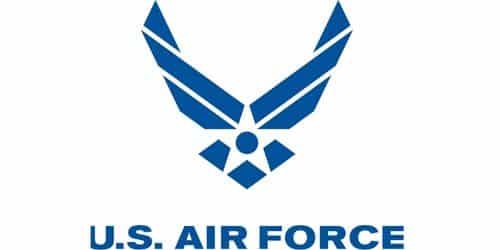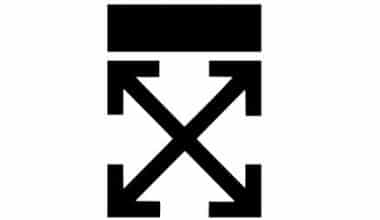The Air Force Symbol is the official logo of the United States Air Force. This monument is both a celebration of history and a symbol of potential. Also, it modernizes the “Arnold” wings and stars with a circle to symbolize today’s advanced air and space forces. The U.S. Air Force logo is made up of two parts: the wordmark “Air Force” and an image that might be interpreted as either an eagle or a medal. Furthermore, the basic meaning of the United States(US) Air Force logo is the reward for aerial victory. The United States Air Force logo symbolizes power, commitment, and bravery. This ensures the mother country’s appreciation. The symbols allude to the openness of space and the blue of the sky. In this article, we will talk about the history of the United States Air Force logo.
Air Force History
The United States Air Force (USAF) is one of the United States’ eight uniformed services and is in charge of air operations. Although the United States Air Force (USAF) dates back to August 1, 1907, when it was formed as a division of the U.S. Army Signal Corps, it did not become its own military service until 1947, when the National Security Act was passed. However, this service is the second-youngest in the United States Armed Forces[a] and the fourth most important. Priorities for the United States Air Force include air superiority; global integrated intelligence, surveillance, reconnaissance, rapid global mobility, global strike; and global command and control.
Furthermore, the United States Air Force (USAF) is a military service branch that operates under the DoD’s Air Force Department. The President picks a civilian to be the Secretary of the Air Force, and the Senate confirms that choice. They report to the Secretary of Defense. However, the Chief of Staff of the Air Force is the highest-ranking military official in the Air Force, in charge of all Air Force units, and a member of the Joint Chiefs of Staff. Some parts of the Air Force are sent to unified combatant commands in response to directives from the Defense and Air Force secretaries. The combatant commanders are in charge of running the assigned forces. In addition, the Secretary of the Air Force and the Chief of Staff of the Air Force are in charge of the Air Force members.
The US Air Force operates independently and rescues soldiers. 2017 has 5,369 military planes and 406 ICBMs. 329,614 active-duty personnel; 172,857 civilians; 69,056 reserve airmen; and 107,414 Air National Guard airmen make up the world’s largest air force.
Key Areas of Air Force Concentration
- Precision engagement: Achieving one’s goals with as little danger and collateral harm as possible removes the enemy’s safe haven.
- Aerospace supremacy: The freedom to act depends on one’s ability to regulate the flow of air and space.
- Rapid global mobility: The fast deployment of soldiers anywhere in the world assures a level of responsiveness never seen before.
- Information superiority: When it comes to making important policy calls, having access to and the capacity to effectively use relevant data is crucial.
Airforce Logo (Overview)
The Air Force is one of the eight branches of the United States Armed Forces. After the National Security Act was passed in 1947, the American Legion changed from being part of the army to being an independent fighting force. The department was one of the three that make up the Ministry of Defense of the United States and first appeared within its framework. The U.S. Air Force is the official name of this organization (USAF). The Pentagon in Virginia serves as the organization’s headquarters.
Furthermore, in the late 1990s, it became clear that the Air Force needed a global logo to represent its core beliefs and ideals. In 1998, the company hired a corporate branding agency to do research, polls, and focus groups for it.
Eric Livingston made the official U.S. Air Force logo in 1999. It was shown to the public for the first time in January 2000. Seven months later, it began appearing on gates and water towers, marking the beginning of the testing period that would last until 2002. After some time, in 2004, the design was officially adopted as the Air Force’s symbol.
- Established on September 18, 1947
- The United States of America, in county of Arlington, Virginia, is home to the organization’s headquarters.
Airforce Logo Meaning and History
The Air Force’s symbols represent the service’s values, missions, and objectives. In addition to the United States Air Force logo that was officially accepted in January of 2000, it also has a distinguishing symbol that appears on chevrons, a flag, and other apparel.
Furthermore, its origins can be traced back to the late 1990s, when the United States Air Force headquarters approached a private firm with a request for assistance in the development of a new logo. The company’s brand ambassadors visited key towns and military installations to gather insight into employee beliefs, perform research, and see things for themselves. In addition, the production team spent considerable time at military air points learning about the local culture and history.
It took a lot of time, but the final product was a fantastically unique United States Air Force logo. The modernized Air Force logo is founded on time-honored military ideals and is respectful of long-standing customs. The suggested layout shows how the service can protect US airspace and US interests now and in the future.
Furthermore, there were multiple phases to the project. Initial polls, surveys, and focus group collaboration took place in 1998. It wasn’t until a year later that a graphical icon began to be used.
History Continues
The original Air Force logo was black and white. The Air Force version of the Air Force logo looked like this. At the end of spring 2000, the writers put in a request to register the trademark. In 2001, the entire military put it to the test in the field. The Air Force’s symbols represent the service’s values, missions, and objectives. In addition to the United States Air Force logo that was officially accepted in January of 2000, it also has a distinguishing symbol that appears on chevrons, a flag, and other apparel.
In the late 1990s, the US Air Force headquarters asked a private company for help making a new logo. The company’s brand ambassadors visited key towns and military installations to gather insight into employee beliefs, perform research, and see things for themselves. In addition, the production team spent considerable time at military air points learning about the local culture and history. It took a lot of time, but the final product was a fantastically unique United States Air Force logo. The new, updated Air Force logo is based on time-tested military ideas and follows long-standing traditions. The suggested layout shows how the service can protect US airspace and US interests now and in the future.
The 1998 Airforce Logo Project
The project has stages. In 1998, polls, surveys, and focus groups began. One year later, a graphical United States Airforce logo was utilized. The original black and white version of the Air Force logo looked like this. At the end of spring 2000, the writers put in a request to register the trademark. In 2001, the entire military put it to the test in the field. Also, research from 2002 shows that 90% of the target audience knows that the United States Air Force logo is a real USAF trademark. He was given his serial number and registration card in the early fall of 2003, and the chief of staff gave his stamp of approval in May of 2004.
The United States Airforce Logo Evolution 1947- Today
The Department of Defense uses a circular stamp-like logo as its primary identifier. At the center of the rondel’s wide border is the armed forces branch’s name. The national logo of the United States Airforce, the bald eagle, is featured front and center. On a brand-new Airforce logo, he is likewise rendered in the Cubist style. During the early years when the United States Air Force was still a part of the army, they utilized the ancient logo.
The history of the famous flying bird logo goes back to World War II, when it was linked to Air Force General Henry Harley Arnold. However, the United States Air Force logo appears to have been pieced together from various trapezoids, triangles, rhombi, circles, and parallelograms with one side removed. Also, when the United States Airforce logo is arranged in a certain way, it looks like a bald eagle in flight.
The lineage of the current iconic flying bird logo can be traced all the way back to World War II, when it was connected to Air Force General Henry Harley Arnold. However, the United States Air Force logo appears to have been pieced together from various trapezoids, triangles, rhombi, circles, and parallelograms with one side removed. In addition, when the United States Air Force logo is placed in a specific pattern, it evokes the image of a soaring bald eagle.
The United States Airforce logo features a five-pointed star at its center. At the expense of white space, the emphasis was placed on color contrast and clean lines. One can make out a blue circle at the center, from which white lines radiate out in all directions. The U.S. Air Force is written in smaller letters below.
The United States Airforce Logo Font and Color Scheme
Each individual and the service as a whole are represented by their own logos. However, the bald eagle is the national logo of the United States Air Force, so even though these items are manufactured in diverse designs, they all share this logo. The first one is traditional and realistic, while the second is more abstract and reminds me of Cubism.
The letters in the Air Force logo are almost an exact match for the Craft Gothic Heavy Extended font by FontSite Inc. It’s a thick, chunky, sans-serif font that’s big, bold, wide, and stocky. Because blue represents the sky and white symbolizes purity, the blue and white color scheme is the dominant one for the military unit linked with flying.
Are They Changing the Air Force Logo?
This new logo for the Falcons pays tribute to their history while also looking ahead to their bright future. However, this new logo will be seen as a new mark for spirit wear, but the Academy “Air Force” and the bolt-on sporting uniforms will remain the official logo and official mark, respectively.
The Interesting Facts About the US Air Force
The United States Air Force has been an influential military branch since its first establishment in 1947. However, there are more than 325,000 people serving in the military’s second-largest service. Even though it’s one of the youngest of the five-armed branches, its strength is undeniable. The United States Air Force (USAF) has a fascinating history that few people are aware of, including exclusive missions flown, sound barrier records broken, and even the tracking of Santa Claus. Here are some of the fascinating facts about the US Air force
#1. Airmen Welcome Their New Commander by Stomping on His or Her Roof
In the Air Force, a “roof stomp” is a way to welcome a new commander or mark a special event. People climb on the roof of the commander’s house and make noise, while others knock on the windows and doors below. It’s like an episode of “The Walking Dead,” but without the zombies.
#2. The Air Force Band Shoots Music Videos
Music is an integral part of everyday life in the armed forces. By hiring musicians and singers, the U.S. Air Force hopes to provide entertainment for the public and boost the morale of its service members. The United States Air Force is home to a number of musical ensembles and even has its own channel on YouTube.
#3. They Built a Supercomputer Out of Sony Playstations
The Air Force Research Laboratory made a supercomputer called the Condor Cluster so that it could look at high-definition satellite pictures. The supercomputer consists solely of 1760 Playstation 3 consoles joined together. In addition, it is the 33rd most powerful computer that can be found anywhere on the globe.
#4. An American Air Force Captain Was the First to Fly Faster Than the Speed of Sound
In 1947, Captain Charles Elwood Yeager was the first person to travel faster than the speed of sound. As a test pilot, he was in control of a Bell X-1 aircraft powered by rockets. At an altitude of 43,000 feet, he hit a high speed of 700 miles per hour. In his later years, he helped prepare military pilots for careers as astronauts. Also, he was in charge of a number of things before he left the Air Force in 1975.
#5. The Air Force Tracks Santa
Watching and following Santa Claus as he travels around the world on Christmas Eve is probably one of the coolest jobs that members of the Air Force are entrusted with doing. Every December, the North American Aerospace Defense Command, also known as the Air Force, makes the NORAD Santa Tracker available online so that people can follow Santa Claus as he travels across the world.
#6. A Common Springtime Phenomenon Among Airmen Is an Increase in Facial Hair
Members of the United States Air Force follow the “Mustache March” tradition every year. In honor of Brigadier General Robin Olds, a USAF legend, WWII and Vietnam veteran, and triple ace, airmen grow mustaches for the whole month of March.
#7. The Air Force Has a Lot of Regard for North Dakota
At the height of the Cold War, North Dakota housed so many nuclear weapons for the United States Air Force that it would have been the world’s third-largest nuclear power had it seceded from the United States. North Dakota is south of the border, but we’re not at war, so I doubt you’ve noticed.
#8. Their Forecasters Are Like the Military Elite
They go to Combat Control School at Pope Field in North Carolina, Air Force Basic Survival School for water survival training, Air Force Underwater Survival School for underwater egress training, Army Airborne School at Fort Benning in Georgia, and Hurlbert Field for special tactics training. Aside from MARSOC and SEAL teams, they usually work with Air Force and Army SOF.
#9. Only the Air Force Engages the Soviet Union in Open Conflict
During World War II, the United States and the Soviet Union engaged in a pitched battle, often known as a “dogfight,” over the town of Ni in Serbia. But it wasn’t clear how the event would end, and both governments kept the details of what happened secret.
#10. Chuck Norris Was a Member
Chuck Norris became interested in martial arts while he was stationed in Korea. He realized he couldn’t do his job as an air policeman (now called Security Force) because he was too weak. The fact that he was dubbed “Chuck” was also a result of this.
Why Is the Air Force Logo a Lightning Bolt?
The design of the Air Force Seal’s shield is a perfect copy of Jupiter’s lightning bolt. However, the Roman mythological sky deity, Jupiter, represented all that was above.
The Air Force’s colors are represented by the blue background of the shield and the gold of the lightning bolt. The potential of the weapon is symbolized by the lightning bolt. In addition, the powerful tiger is a metaphor for our battling spirit and toughness.
What Is the Motto of the Air Force?
Each military service has its own motto that serves as a symbol of its proud tradition of devotion to the country. The Army, Marines, Navy, Air Force, Coast Guard, and Space Force each have their own unique logo to represent their core beliefs.
Furthermore, the U.S. Air Force’s motto is “Aim High…”, which is both a rallying cry and a promise, and it was formally approved in 2010. The Air Force is always reaching for (pardon the pun) greater heights, and its members are held to the same standard.
In a survey that was sent out to the whole Air Force, airmen said that they wanted a slogan that reflected the diverse culture of the Air Force and said something about what it meant to be an airman. To that end, “Aim High… Fly-Fight-Win” pays tribute to the history of the United States Air Force while providing inspiration to the service members of today.
What Is the Air Force Oath?
This is proof that I, ___________, solemnly swear (or affirm) that I will support and defend the Constitution of the United States against all enemies, foreign and domestic; that I will have true faith and allegiance to the Constitution; and that I will obey the orders of the President of the United States and the orders of the officer in charge of me, according to the rules and the Uniform Code of Military Justice. And may God rescue me. ”
Also, read: Time In Force: Complete Definitive Guide for Beginners and Pros (+ tips on investing)
What is the Air Force Creed?
I serve my country in the United States Air Force.
I am warrior
I’ve decided to answer the call of my country.
That’s right, I serve in the United States Air Force as an airman
The goal of my life is to conquer the skies, the battlefield, and the world
I hold true to a glorious past, a noble custom, and a heroic lineage.
I serve my country in the United States Air Force.
Keeper of the Flame of Liberty and the Flame of Justice, Sword and Shield of my Country, Watchman, and Defender of the Homeland
My life is on the line to protect my nation
I serve my country in the United States Air Force.
Companion, Chief, Hero.
I will never give up or give in, and I will never abandon my fellow airmen.
What Is the Air Force Yell?
The Air Force yell is the Hooah. The U.S. Army, U.S. Air Force, and U.S. Space Force all utilize the war cry “Hooah”. In 1841, Seminole commander Coacoochee greeted regiment leaders with a loud “Hough!” The 2nd Cavalry used the war cry first. However, following its widespread adoption by the American military after World War II, the term came to mean “anything but ‘no,'” and has since taken on this broader meaning.
The United States Army Rangers came up with the term, and by the early 1980s, it was used a lot in the areas around Fort Lewis, Washington, and Fort Benning, Georgia, which are bases for the Rangers. By the end of the 1980s, it had spread to the Army’s leadership development schools and more difficult courses like Airborne, Air Assault, and Pathfinder. It had also reached the vast majority of the Army’s major and subordinate commands.
However, some believe the rapid acceptance is due to the Rangers’ PCS from the “Bats” to another divisional unit. G3 Training can then hire them as instructors or Black Hats to fill division cadre openings. In 1986, the head instructor of the Primary Leadership Development Course (PLDC) at Fort Ord, California, stressed how important it was to use the word “Hooah” in a positive way. When someone says, “I absolutely agree, that’s badass!” they mean it. or “I got it, and I’ll get it done”
Who Designed the Air Force Emblem?
The “Hap” logo, which was used by the United States Air Force during World War II, served as the inspiration for the Air Force’s official emblem. The present version was written by a commercial company that was commissioned to write it. However, the name of the company has not been made public.
Is There a Copyright on the Air Force Logo?
The Air Force logo is licensed and protected by copyright laws. All of its trademarks are protected by law and may not be used in any way. Only the Air Force can use its trademarks to market items.
What Are the Core Values of the United States Air Force?
The beliefs for which an individual or group is willing to make sacrifices over time are known as their values. Fundamental to our very being, “core” values are the bedrock upon which our society is built. Integrity First, Service Before Self, and Excellence in All We Do are the guiding principles by which the United States Air Force conducts itself.
Also, being an officer, enlisted, civilian, active, guard, or reserve member of the Air Force means agreeing to live by these ideals both on and off duty. This is what our profession and the American people expect of us.
Our respect for the Air Force, each other, and the mission is shown in how we follow the rules. Members of the Air Force serve our country with honor, bravery, and professionalism. In addition, the way we carry ourselves speaks volumes about who we are as a unit and what we stand for in the world at large.
Conclusion
The recommended location for the badge “U.S. Air Force” when used in conjunction with the logo is just below the logo, but its inclusion is not necessary. However, there should be a 15% margin of separation between the symbol and the logo, regardless of whether it is placed to the right or left of the symbol. No version of the Air Force logo is allowed in which the logotype is placed above the symbol.
Similar Posts
- California Small Business Grants: Top 13+ picks for Minorities & Veterans (+ Application Guide)
- 7 SMALL BUSINESS BRANDING IDEAS THAT WILL YIELD YOU MORE PROFIT
- Swiss Watch Brands: Top Affordable Swiss, Updated (+Detailed Guide)
- FORCE MAJEURE CLAUSE: Samples In Contracts






